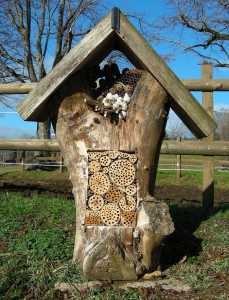
This creative bee hotel uses bamboo and holes of the proper sizes drilled in logs to attract solitary bees. And it’s kind of fun to look at too.
Insect pollinators seem to be receiving some overdue attention these days. Pollinator insects provide incalculable services to humans via increased fruit production and crop pollination. According to the USDA’s Natural Resource Conservation Service, 3/4 of the world’s flowering plants and about 35 percent of the world’s food crops depend on animal pollinators to reproduce.
This new interest in bees is resulting in a renaissance of a sorts in creative ideas for attracting and sheltering pollinator insects in backyards and parks and even hotels. In European hotels and hostels I’m told it’s not uncommon to see bee hotels like the one pictured here. Click here for more inspiration, but keep in mind that in Texas some of these designs will attract ants and spiders as well. If you’re OK with that fact, I think you can have some fun with this.
The idea of drilling holes in wood for bees comes from the fact that many solitary (non-stinging) bees prefer to nest in natural cavities in wood or stone. These bees, many of which are excellent pollinators, often lack good nesting sites in urban and suburban settings. By providing artificial homes for these fascinating insects, we can help conserve their numbers in our increasingly urbanized landscapes. you might even up the production of tomatoes and squash in your backyard vegetable garden.

Osmia, a species of mason bee, is a highly beneficial pollinator that can be attracted to artificial bee hotels.
I can’t go into details on how to construct these “hotels” here, but there are many good sites that do. To get inspired to start, check out the Native Bee Nest Site Project on Facebook. For a free copy of a whole book on rearing Osmia, blue mason bees–one of our prettiest and efficient native pollinators–check out the Sustainable Agriculture Research and Education site.
In the interest of full disclosure, my first attempt at creating a bee hostel last summer was not a spectacular success. I did not manage to attract any bees, though I did get some lively acrobat ants. But I am not discouraged. This summer I’m modifying my bee shelters to get better overhang on the front porch, and will try re-positioning them. South-facing nests are supposedly better, though I’m not convinced that bees in Texas are dying for more direct sunlight. I also plan to try drilling holes in wood blocks, and looking for some properly sized straws to allow me to clean out any nests that do form. Dr. Christine Casey, with the University of California, has also provided a short, but useful, fact sheet on how to build your own hotel.
By the way, if you’re still a little worried about inviting any kind of bee to your backyard, remember that solitary bees rarely sting. Besides, these interesting and active insects add immeasurably to the gardening experience. A garden without the satisfying hum of bees in the summer would be a pretty dull place indeed.